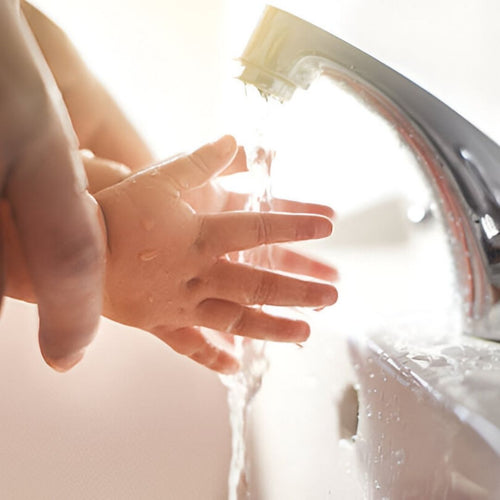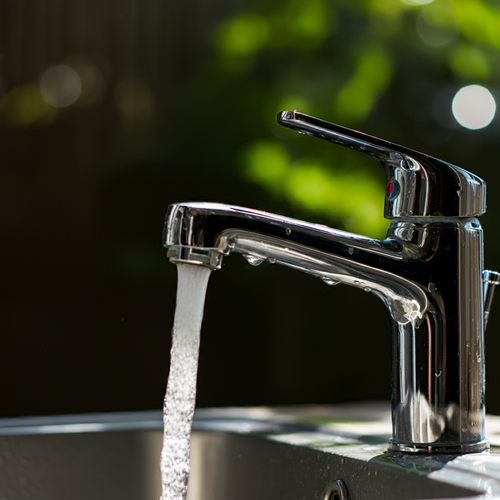Understanding Iron in Well Water
Iron often plays the unwanted guest in well water, showing up uninvited. It's the culprit behind some rather pesky problems—from turning your water a lovely rust hue to leaving an unappetizing metallic tang.
So, what sorts of iron are lurking in our well water, and how does an overload of this metal throw a wrench into the works?
Types of Iron in Well Water
Discover the benefits of the Iron Master Filter for effectively removing iron from well water.
The Iron Master Filter is an effective solution for managing iron in well water.
Well water has a few different faces of iron, each its own bit of mischief to manage getting rid of:
- Ferrous Iron (Clear Water Iron): Sneaky and invisible until it hits the air, then boom! It oxidizes into ferric iron.
- Ferric Iron (Red Water Iron): You can't miss this one—it's what gives the water that rusty tint we're all too familiar with.
- Colloidal Iron: Tiny daredevil particles causing a murky mess and tricky to sift out.
- Organic Iron: Teaming up with organic matter, this iron is tricky, hanging out in places rich with decaying stuff.
- Bacterial Iron: This one tags along with iron bacteria, creating gooey piles that play havoc with your pipes and filters.
| Iron Type | Description |
|---|---|
| Ferrous Iron | Invisible, dissolved, turns rusty when aired |
| Ferric Iron | Rusty particles, leave water red |
| Colloidal Iron | Fine, floating particles causing murkiness |
| Organic Iron | Iron links with organic goop |
| Bacterial Iron | Sticky iron-bacteria mix clogging things up |
Effects of High Iron Concentration
Use the SoftPro Water Calculator to determine the best iron removal system for your well water needs.
Too much iron in your well water gives you more than just a few headaches:
- Turbidity and Discoloration: Iron overload makes your water look like muddy soup—yep, it stains anything it touches, from your bathroom fixtures to your favorite shirt.
- Metallic Taste: If you like your drinks with an iron kick, you’re in luck—otherwise, this taste is best avoided.
- Maintenance Costs: All that iron having a party with oxygen turns into rust, sending your repair bills sky high and leaving your plumbing and gadgets grumbling.
- Health Concerns: Overdoing it on iron in your water can upset more than just your belly, leading to potential poisoning for heavy drinkers.
| Effects of High Iron Concentration | Description |
|---|---|
| Turbidity and Discoloration | Turns water black/dingy, wreaks havoc on household items |
| Metallic Taste | Not the taste you want in your morning coffee |
| Increased Maintenance Costs | Pipes get rusty, and so do wallets—if you get our drift. |
| Health Concerns | Possible tummy trouble and worse with long-term exposure |
Knowing these troublemakers helps us pick the best moves to kick iron's unwanted effects out of our water.
Removing Iron from Well Water
Dealing with iron in well water is like trying to catch a fly with chopsticks—it can be a nuisance but definitely doable with the right approach.
We've got several systems to help kick that pesky iron to the curb and keep your water as fresh as a mountain stream. Picking the best option for your home just means understanding a few basics.
Causes of Iron in Well Water
Iron naturally exists in the earth's crust and often makes its way into well water through various processes:
- Natural Erosion: As water flows through soil and rocks, it dissolves iron minerals, carrying them into underground aquifers that supply wells.
- Well Construction Materials: Iron pipes, casings, or fittings in older wells can corrode over time, releasing iron particles into the water.
- Surface Contamination: Shallow wells or poorly sealed systems may allow organic matter or iron bacteria from the surrounding environment to enter the water supply.
Understanding how iron enters your well water is crucial for selecting the right treatment solution.
Detecting Iron in Well Water
Iron contamination often reveals itself through noticeable changes in water quality. Here are some common signs:
- Rusty Stains: Red or orange stains on sinks, tubs, and laundry are a clear indicator of ferric iron.
- Cloudy or Colored Water: Water may appear yellowish or brownish due to oxidized iron particles.
- Metallic Taste: A sharp, unpleasant metallic flavor in drinking water is a sign of dissolved ferrous iron.
- Slimy Deposits: Iron bacteria can create sticky, slimy buildups in pipes and fixtures, often accompanied by a foul odor.
These symptoms not only affect aesthetics but can also cause damage to plumbing and appliances if left untreated.
Health Impacts of Iron in Drinking Water
Although iron is not considered a primary health hazard, excessive amounts can lead to certain issues:
- Digestive Discomfort: High levels of iron may cause stomach upset for some individuals.
- Iron Overload Risks: People with conditions like hemochromatosis (a disorder where the body absorbs too much iron) should avoid consuming high levels of iron from any source, including water.
- Bacterial Growth: Iron-rich environments encourage the growth of bacteria, which can pose additional health risks if not properly managed.
While most people won’t experience severe health effects, addressing high iron levels improves overall water quality and safety.
Environmental Effects of High Iron Levels
Iron contamination doesn’t just affect your household—it can also impact the surrounding environment:
- Soil Quality: Excessive iron runoff can alter soil composition, potentially affecting plant growth and agricultural productivity.
- Water Ecosystems: Discharging untreated iron-rich water into nearby streams or ponds can disrupt aquatic ecosystems by promoting algae growth and reducing oxygen levels.
Proper treatment systems not only benefit your home but also help protect local ecosystems from damage.
Testing Your Well Water for Iron
Testing your well water is the first step to identifying and addressing iron contamination. Here’s how you can do it:
- Professional Lab Testing: Sending a sample to a certified lab provides detailed results about the type and concentration of iron in your water.
- At-Home Test Kits: These kits are convenient for quick checks but may not differentiate between different forms of iron.
- Visual and Taste Clues: Rust-colored stains, metallic taste, or slimy buildup are often signs that testing is needed.
Annual testing ensures you stay ahead of potential problems and maintain safe water quality.
Common Iron Removal Systems
Households with well water often need specific systems to tackle the iron monster under the kitchen sink. These differ in tech, price, and efficiency. Let's dive into the nitty-gritty of some popular teams:
- Iron Removal Plants: Like bringing in the big guns, these systems use oxidation and filtration to banish iron out of sight.
- Iron Water Filter Systems: These guys use green sand, oxidizing filters, and other tricks to nab those iron particles.
- Reverse Osmosis Systems: They play hardball by squeezing water through special membranes, catching iron along with other sneaky contaminants.
- Chemical and Biological Iron Removal Systems: Chlorine or a good ol' puff of air turns iron into stuff that’s easily filtered out.
- Clarifier Systems: This old-school method lets heavy iron particles throw a party at the bottom of a tank before filtering them out.
| Iron Removal System | How It Works | Effectiveness | Pros | Cons |
|---|---|---|---|---|
| Iron Removal Plants | Oxidation and Filtration | High | Powerful, handles big jobs | Pricey, tough to set up |
| Iron Water Filter Systems | Various filtration tricks | Moderate to High | Custom options, wallet-friendly | Needs TLC regularly |
| Reverse Osmosis Systems | Membrane magic | High | Kicks out lots of bad stuff | Costs a pretty penny, slow |
| Chemical and Biological Systems | Oxidation | Moderate | Great for certain iron types | Needs a bit of chemical love |
| Clarifier Systems | Let’s particles chill and settle | Low to Moderate | Easy as pie | Not for iron overloads |
Choosing the Right Filter
Ready to pick the perfect team for well water rust-busting? Here’s what you gotta keep in mind when shopping around:
-
Iron Levels: Start by checking how much iron you've got. For water that looks more like rust soup, systems like the SoftPro Iron Master are champs at tackling loads of iron, manganese, and stinky sulfur without slowing your flow.
-
Daily Water Usage: Think about your household's thirst. Options like the SoftPro Iron Master bring air power to oxides iron the natural way. It's known for having parts that you can count on, doesn't break the bank, and even offers a lifetime promise.
-
Extra Troubles: Peek at other unwanted guests in your water. Thanks to the Iron Master AIO Iron Filter for Well Water by SoftPro that handles hard water, germs, and funky smells, making your tap water quality on par with a fancy bottled brand.
-
Tech Preferences: What's your style? Reverse osmosis does a bang-up job but might move as slow as a Monday morning. Biological setups need regular attention with chemicals.
-
Money Matters: Keeping up-front and upkeep costs in check is key. SoftPro is pretty slick at keeping your budget in mind while tackling several issues.
With all this know-how, we're on our way to nailing down the best rust-busting system for us. The right choice not only makes things iron-free but also keeps our water crisp and tasty, just how we like it!
Top Rust Removal Systems
Discover the benefits of the Iron Master Filter for effective rust removal.
If you're dealing with rust in your well water, the Iron Master Filter is key to choosing the right system—nobody likes unwelcome mineral guests!
If you're one of those folks dealing with rust in your well water, choosing the right system is key—nobody likes unwelcome mineral guests!
Let's check out the most recommended well water rust removal system that can help you enjoy water that's clean, fresh, and rust-free.
SoftPro Iron Master
Use the SoftPro Water Calculator to assess your well water needs and find the best solutions for iron removal.
Touted as the top iron filter for well water, the SoftPro Iron Master uses Air Induction Technology for natural iron oxidation. Famous for its certified parts and lifetime warranty, this system's a mix of effectiveness and economy.
Key Features:
- Air Induction Technology for natural iron fight
- Certified high-quality components
- Lifetime warranty tag
- Wallet-friendly
Preventing Iron Contamination
Prevention is always better than cure when it comes to managing iron in well water. Here’s how you can reduce the risk of iron in your water:
- Regularly inspect and maintain well components to prevent corrosion or leaks.
- Install proper seals and covers to block surface contaminants from entering the well.
- Test your water annually to monitor changes in mineral content and address issues early.
- Consider upgrading old pipes or fittings that may contribute to rusting over time.


















![Aldex Premium 10% Cross Link Resin for Water Softener [High Capacity]-SoftPro® Water Systems](http://www.softprowatersystems.com/cdn/shop/files/Aldex_10_Cross_Link_Resin_Premium_High_Capacity_for_Water_Softener_600x.jpg?v=1735853599)
























